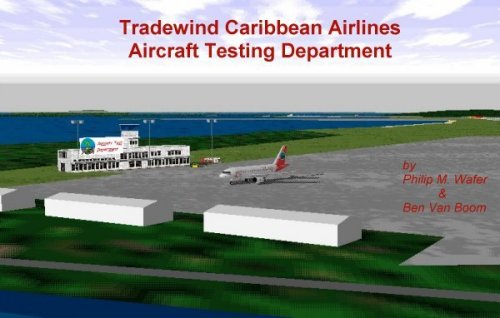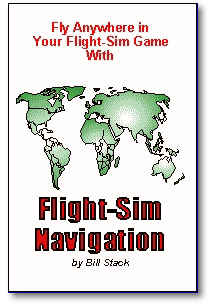

A review of "Flight-sim Navigation by Bill
Stack"

The book is aimed at the Flight Simulator enthusiast who wants to
"fly anywhere". It is an A5 sized, ringbound book, and
is about 160 pages with 9 main chapters, appendices and an index.
Being ring bound, it is very easy to use on the desktop. It can
be folded out to view 2 pages or even easily folded back around
to view only one page, without any damage to binding or pages
(unless you place it down on spilled coffee :-)). The print type
used makes reading easy. From the title it can be seen that this
book is not to be used for real world flight training and Bill
has the relevant disclaimer on page 4.
Over the chapters you are taken from fundamentals to GPS,
aviation charts to dead reckoning, abbreviations to definitions,
explanations to flight chart suppliers. Basically how to get from
A to B, what considerations need to be made, and if you have
limitations how to overcome them. You can learn how to fly around
the world even if you only fly the Cessna 182! (Hmmmm..I might
just try that!)
There are various ways of navigating, for example following the
roads and reading from a roadmap. But of course you have to be
able to see the roads…well, I'll fly at an altitude where I
can see the road. What if it's foggy when flying between A and B
for part of the journey? Will I get lost? Will I crash into a
hill? If you want to fly cross-country flights using Visual
Flight Rules then you are restricted by weather. Following the
roads might not necessarily be the most efficient way of
travelling between two airports. Low altitudes might not be fuel
efficient. If you fly at high altitudes, clouds might block your
viewing visual landmarks.
Bill explains the various ways of navigating, what aids are
available and what equipment the aircraft needs. I mean, it's no
use navigating using GPS if the aircraft lacks the receiving
equipment. By the way, where are we and where are we going? Will
our aircraft take off from a runway of this length? Have we a
suitable runway length at the destination? It's no use trying to
land a Jumbo at Saba! …even if you COULD find your way to
Saba! Read and learn.
Navigation charts…do you have any? Maybe you need them.
Modern Flight-simulations go to quite a depth of realism, where
real world charts are useful. Next, what's on the charts and how
do you read them? Chapter 2 has the details, what type of charts
are available and where to get them and when to use them. It's a
big help in planning (which is covered in detail in chapter 3).
They show where navaids, airports, intersections, Flight
Information Regions, ATC areas, restricted areas etc are in the
real world and you can incorporate these into you flights. Bill
coverage of this subject is comprehensive. Procedures for
Instrument Flight are covered in detail in Bills'
"Instrument Flying for Flight Simulator Pilots".
Wind Compensation has it's own chapter. With real world weather
now available in FS2000 it is important to know how to deal with
this factor in any flight, how it affects planning, fuel
management, time to destination, track versus course and heading,
how it affects the take-off and landing phases etc. I found the
information very useful. At one stage I thought there was a bug
in FS98 where the aircraft tended to turn INTO the crosswind on
the take-off roll. Bill explains that this is what's called the
"weathervaning" effect. You learn something new every
day!
In the chapter on "Long Range Navigation" there are
some exercises at the end. I tried out the third one, San
Francisco to Honolulu. Well…I did Los Angeles to Honolulu in
a DC10 with a dead reckoning course of 240° magnetic.
Interesting…I ended up about 120nm North of the island chain
and picked up one of the NDBs. Not bad for a first go! I
generally fly transoceanic using GPS. But the classic airliners
didn't use GPS! Bill explains the methods in this chapter.
This book is a must have for the flight simulator pilot. You
don't want to be flying the Cessna around Meigs all you life, do
you?
For more details see Bill Stacks' home page at http://www.topskills.com/fsn99.htm
and buy a copy!
Philip M. Wafer
Jan 2000